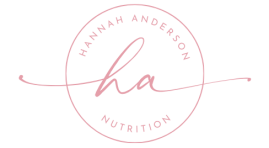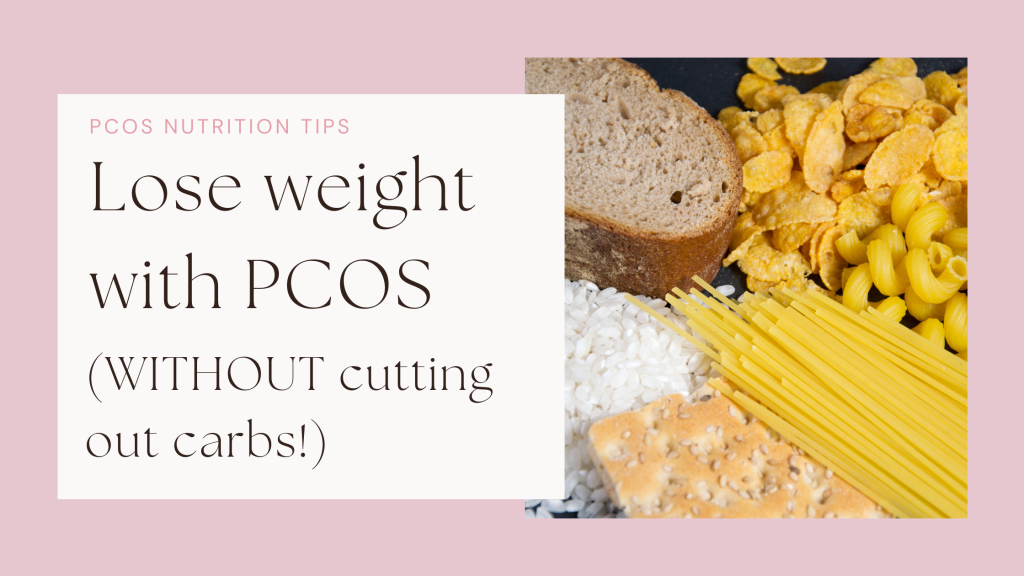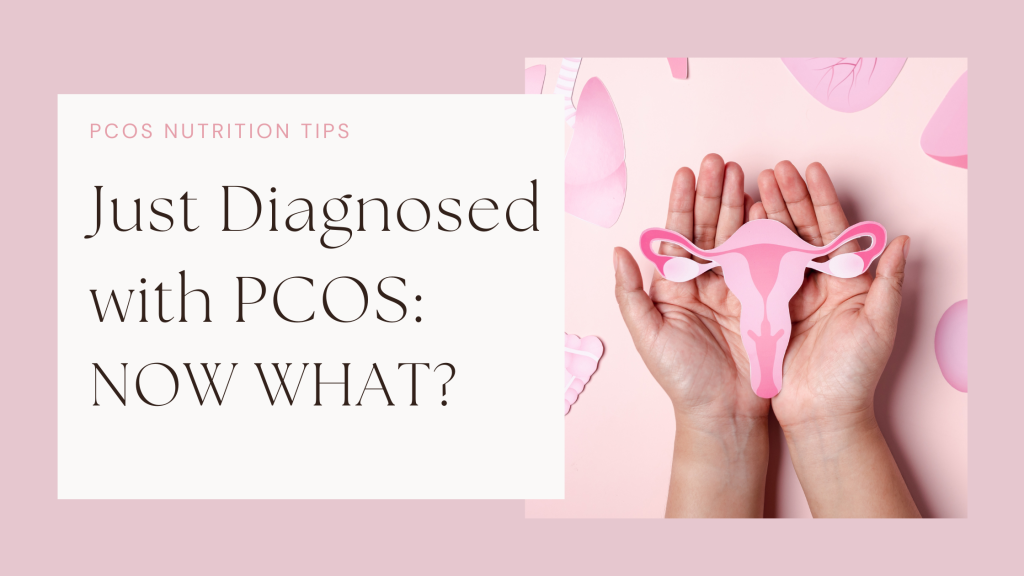Feeling overwhelmed and lost whenever you step foot into a grocery store? Wish you just had a PCOS grocery list to tell you exactly what to put in your cart?! This article is for you!
While there’s no one-size-fits-all approach to naturally managing PCOS, a thoughtfully curated grocery list can help you eat for hormone balance, reduced inflammation, and improved insulin sensitivity.
Here’s your guide to grocery shopping with PCOS in mind, complete with nutrition keys, practical tips, and a master list to set you up for success.
This post contains affiliate links. This means that if you click on the link and purchase the item, I may receive an affiliate commission at no additional cost to you. Thanks for your support so I can keep creating valuable content like this post.
Nutrition Keys for PCOS
First, let’s discuss the role of nutrition in managing PCOS so you can understand the method to my madness with the PCOS grocery list below.
Here are the foundational nutrition principles of eating for PCOS nutrition (check out this article if you want a deeper dive into these!)
- Focus on Complex Carbs:
No, you don’t have to completely cut out carbs with PCOS! In fact, complex carbs help stabilize blood sugar levels, reducing insulin spikes. Research shows that a diet full of low glycemic foods (like complex carbs) can help restore ovulation and promote hormone balance for women with PCOS (Marsh et al., 2010). - Prioritize Anti-Inflammatory Choices:
Chronic inflammation is a common root cause of PCOS. Omega-3 fatty acids (like those found in fatty fish) and antioxidants (in berries and leafy greens) can help reduce inflammation and balance hormones (González et al., 2018). - Choose High-Fiber Foods:
Fiber slows digestion and promotes satiety, which can improve energy levels and promote healthy weight (Cunha, M. B., et al., 2019). - Include Lean Proteins:
Protein is crucial for stabilizing blood sugar and supporting muscle health. Lean meats, fish, eggs, and plant-based options like tofu are excellent staples. - Embrace Healthy Fats:
Incorporating healthy fats from avocados, nuts, seeds, and olive oil can support hormone balance and reduce inflammation (Faghfoori, Z., et al., 2017).
The PCOS grocery list below will help you hit all these nutritional marks so you can feel your best with PCOS!
Tips for Grocery Shopping for PCOS
Grocery shopping with PCOS doesn’t need to be complicated or overwhelming. Here are some tips to make it more manageable and enjoyable:
1. Plan Ahead
Success actually starts long before you set foot in the grocery store and doing some pre-planning can make all the difference! So, it can be helpful to create a menu plan for the week and then create your grocery list off of that menu.
This can help minimize impulse buys and ensures you’re prepared with balanced options when the week gets hectic. Almost all my clients say meal planning is hands down the one thing that most helped them crush their goals! Be sure to check out my free 7-day PCOS meal plan if you want all that hard work done for you!
2. Don’t Just Shop the Perimeter
One of the BIGGEST myths about grocery shopping is that the healthy foods are only located around the perimeter of the store! This seriously drives me bananas! (Which, yes, are in-fact PCOS friendly!) While, sure, there are many whole, nutrient-dense foods found around the perimeter of the store, there are still tons of nutritious options in the center aisles!
These “center aisle” foods are often more budget-friendly and can be total time savers, too (total win-win-win!) Foods such as whole wheat bread, high-fiber pasta, beans, nuts, and oats would all be missed if you only stuck to the perimeter of the store.
Pro tip! You’ll find plenty of nutritious, center-aisle foods in the PCOS grocery list below.
3. Read Labels
Don’t be duped by clever marketing tactics on the front of food packaging. It’s easy to be deceived into thinking a food is healthy when it really isn’t. This is why I always check the nutrition facts label to find the truth! But you have to know what to look for on the nutrition label or you’ll waste your time looking at the wrong things.
Now, it depends on the product, but generally for PCOS I recommend looking at the food label to make sure it’s a good source of fiber and/ or protein. These are key nutrients to help lower insulin levels, reduce inflammation, and controlling cravings (all important for naturally managing PCOS!)
It’s a good source of fiber if it has at least 3-5g per serving, and it’s a good source of protein if it’s at least 10-15g per serving.
4. Buy Seasonal and Frozen
When it comes to adding more fruits and veggies to your plate, seasonal and frozen produce can be a game-changer! Seasonal produce is often more affordable and flavorful. This could mean choosing broccoli and asparagus in the spring, apples and sweet potatoes in the fall, and oranges and pears in the winter.
Frozen fruits and veggies can also be a secret weapon when it comes to eating for PCOS! Frozen fruits and veggies are just as nutritious as fresh (sometimes more-so if they are flash frozen right after being picked!)
The frozen steamer packs are a super quick and convenient way to make sure 1/2 your meal is non-starchy vegetables. They can also be incredibly budget-friendly, so stock up when they are on sale.
4. Stick to Your List
I know, I know! This can be a toughie! But you want to try to avoid adding things to your cart that aren’t on your list and don’t align with your nutrition goals. Now, this does not mean you can’t plan a couple fun foods or fun meals into your week! (I do recommend the 80/20 rule, after all, where you try to eat healthfully about 80% of the time, and then give yourself about 20% wiggle room for those fun foods!)
But, try to avoid those impulse purchases to help you avoid blowing your budget and health goals. To help with this, I really love doing my grocery shopping online or using Walmart’s and Sam’s Club Scan-and-Go (c’mon Costco, when ya gonna get this!)
PCOS Master Grocery List
Now then, here’s a comprehensive list to help you stock your kitchen with PCOS-friendly essentials (you can also get the free PDF download of it here):
Please note: this is not an exclusive list and there may still be other foods that are PCOS-friendly that aren’t listed. This is just a good starting point.
Produce
- Non-Starchy Vegetables:
- Spinach
- Kale
- Broccoli
- Zucchini
- Bell peppers
- Cauliflower
- Asparagus
- Brussels sprouts
- Cucumbers
- Cherry tomatoes
- Broccoli slaw mix
- Chopped salad kits
- Baby Carrots
- Mushrooms
- Mini Bell Peppers
- Fruits:
- Blueberries
- Strawberries
- Raspberries
- Oranges
- Apples
- Pears
- Clementines
- Avocados
- Peaches
- Kiwi
- Bananas
Protein
- Grass-fed beef
- Chicken (Skinless, breasts or thighs)
- Pork loins
- Steak (sirloin or eye of round)
- Chicken meatballs (like Aidells)
- Chicken or turkey sausage
- Turkey bacon
- Ground turkey
- Ground chicken
- Wild-caught salmon
- Tuna
- Mackerel
- Eggs
- Tofu
- Canned tuna
- Canned salmon
- Sardines
- Vanilla protein powder (I like Isopure Creamy Vanilla)
Grains and Starches
- Quinoa
- Brown rice
- Oats (quick, old fashioned, or steel cut)
- Lentils
- Chickpeas
- Black beans
- Sweet potatoes
- Potatoes
- 100% whole wheat bread (at least 3-5g fiber per serving)
- Whole wheat bagels
- Multigrain English muffins
- Boxed mashed potatoes (without any butter or flavorings added)
- Carb smart tortillas
- High-fiber granola (at least 3-5g per serving)
- High-fiber pasta (I’m obsessed with Barilla Protein+)
- Triscuits
- Wheat Thins
- High-protein/ high-fiber pancake mix (I love Kodiak Power Cakes)
- Sweet potatoes
Healthy Fats
- Avocados
- Olive oil
- Avocado oil
- Almonds
- Walnuts
- Pistachios
- Chia seeds
- Flaxseeds
- Pumpkin seeds
- Pesto
- Nut butter (no added sugar, I love Justin’s)
- Hummus
Dairy
- Greek yogurt (unsweetened)
- Whole-fat Milk
- Almond milk (unsweetened)
- Soy milk (unsweetened)
- Hard cheeses (like Parmesan or cheddar)
- String cheese
- Snacking cheese
- Bolthouse Farms Salad Dressings
- Feta cheese
PCOS-Friendly Snack Foods
- Dry-roasted edamame
- Larabars
- KIND Bars
- Nature Valley Protein Granola Bars
- Dark chocolate (70% cocoa or higher)
- Catalina Crunch Snack Mixes
- Air-popped popcorn (like Boom Chicka Pop or Skinny Pop)
- Harvest Snaps
Spices and Condiments
- Cinnamon
- Turmeric
- Low-sodium broth or stock
- Low-sodium soy sauce
- Coconut aminos
- Red wine vinegar
- Apple cider vinegar
- No or low sugar added ketchup
- Mustard
Want to save this list for your next grocery run? Enter your email below and I’ll send it straight to your inbox!
Final Thoughts
Navigating PCOS can feel overwhelming, but having a well-thought-out grocery list is a powerful step toward taking control of your health.
By focusing on nutrient-dense, anti-inflammatory, and blood-sugar-friendly foods, you can create a strong foundation for managing your symptoms.
Happy shopping!
References
- Marsh, K., & Steinbeck, K. (2010). The importance of low glycemic index diets for polycystic ovary syndrome. Journal of Nutrition & Metabolism. https://pubmed.ncbi.nlm.nih.gov/20339363/
- González, F. (2018). Inflammation in polycystic ovary syndrome: underpinning of insulin resistance and ovarian dysfunction. Steroids. https://pmc.ncbi.nlm.nih.gov/articles/PMC3309040/
- Cunha, M. B., et al. (2019). Dietary intake, body composition and metabolic parameters in women with polycystic ovary syndrome. Clinical Nutrition. https://pubmed.ncbi.nlm.nih.gov/30449604/
- Faghfoori, Z., et al. (2017). Nutritional management in women with polycystic ovary syndrome: A review study. Diabetes & metabolic syndrome. https://pubmed.ncbi.nlm.nih.gov/31738333/
Hi! I’m Hannah, your PCOS dietitian! I empower women with PCOS to eat balanced without restrictive diets so they can lose weight and feel their best. Whether through practical tips or grace-filled encouragement, I’m here to guide you every step of the way!



